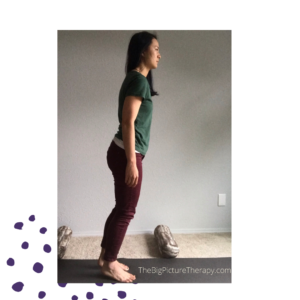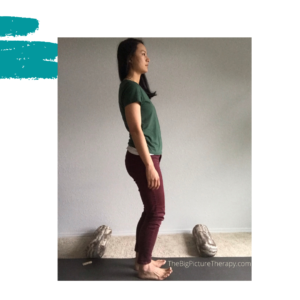Imagine that you hear a very loud noise and you have a split second to decide to run or hide.
The Tendon Guard Reflex (TGR) helps you prepare your body for either choice.
In short a reflex is “a neurological arc that has both a specific stimulus and a predictable response or responses” (Brandes, 2015). See our first blog on what are reflexes and why do they matter for kids if you missed it.
The TGR is activated from an external or internal (psychological) stressor or danger.
This includes emotional triggers too as we know that there are many triggers for the sympathetic fight-flight state.
For example, just thinking about something psychologically threatening such as paying taxes can cause the body to enter a “survival mode” response (see our blog on the sympathetic fight/flight response for lots more on this subject).
This blog talks about how the TGR may have a role in protective survival mechanisms.
Also how its expression in the lower body in particular the feet may affect children emotionally and physically.
The tendon guard reflex can be divided into three manifestations as the Foot Tendon Guard, Upper Tendon Guard (expressed at the neck), and as the Core Tendon Guard (Masgutova, 2015).
Before talking about the Foot Tendon Guard more in depth here is a look at the core tendon guard mechanism.
The core tendon guard mediates the other two responses and helps protect the individual by either triggering a flee or freeze survival response.
Red Light-Freeze
The choice to freeze or flee has been respectively nicknamed the “red light” and “green light” responses by researcher and reflex integration teacher Dr. Masgutova.
In the red-light response, the reaction is to freeze. This triggers a flexion pattern of the muscles, a withdrawal of the core, visual convergence, and reduced movement (Masgutova, 2015).

In my experience, children who consistently default to this response may present as hyper-focused on small details.
They can spend hours focusing on drawing detailed pictures or little objects. They may have a preference for visual convergence and their posture reflects their preference with slouched upper back and flexed core.
They may be more easily triggered into a pattern of shying away from risks and quick to physically and emotionally shirk away from sensory input such as bright light or sounds.
These children may also struggle with noticing the body language of other people in their peripheral vision.
Green Light-Flee
The green light response on the other hand readies the body for movement. Extensor muscles of the back are activated and the effect is a lengthening of the spine.
This response accompanies a slight backwards motion of the trunk, visual divergence (widening of visual field) and preparation for movement in the body.

Mary Rentschler reflex integration specialist, notes that children that display a hyperactive response to this reflex tend to have impulsive tendencies and may be more readily identified as having ADHD (Rentschler, 2009).
This reflexive response considered a “lifelong response,” however after a traumatic event such as after the Sandy Hook shooting or Louisiana Floods survivors were found by the MNRI practitioners on site to have a hyper-active core tendon guard for 4-12 months (Shackleford et al., 2017).
The fear paralysis and Moro reflexes can also be activated alongside the TGR to give the body additional protection. (See the blog on fear paralysis reflex and Moro reflex)
In either case, the hyper-activity of this reflex and sympathetic response leads to increased stress hormones and less time spent playing and learning.
One of the kids I work with is always “on the go,” impulsive, emotionally volatile and is extremely sensitive to touch to his feet. This lead me to suspect that he had difficulties with his TGR especially the..
The Foot Tendon Guard Reflex
Many therapy practitioners including myself have found great results with kids by working the tendon guard reflex at the feet.
The foot tendon guard reflex is a movement pattern that involves the muscles of the foot tendons, achilles tendon and gastrocnemius (calf) muscle (Curlee, 2015).
The pattern affects the lower body and hips with affects up to the spine and muscles of the neck and occiput (Story, 2021).
With the neuro-diverse population I see as a therapist it is common to see some form of toe walking especially with children diagnosed with Autism and also those undiagnosed.
(Often families look to occupational therapy services to help children with unexplained or undiagnosed poor strength, attention and social skills).
When children display a tight gastrocnemius with limited foot dorsiflexion it is a red flag that they may have poorly integrated foot tendon guard reflex.
In my opinion, imbalances in the muscle tension of the body may communicate to the nervous system to remain in a survival state.
Other Causes of Muscle Tension in the Legs
Children who are in a growth spurt can have tight calves and hamstrings.
Growth spurts can also result in general crankiness and emotional rollercoasters.
What to keep in mind for a growth spurt is a change in behavior. For example a child who is typically regulated becoming more emotionally sensitive and volatile.
Other signs of a growth spurt include changes in sleep, increased clumsiness and growing pains in the legs.
There are cases where children may be undiagnosed with Cerebral Palsy and suffering from significant differences in muscle tone.
Refer to a physician if you suspect that a child requires further examination to receive a proper diagnosis.
Children with cerebral palsy often have affected reflexes and reflex integration can be a great tool for these children.
We recommended that you use your professional clinical judgement if you are a therapist and get the assistance of a medical specialist as to whether a specific reflex integration activity would help a specific child.
Why would the foot Tendon Guard affect Emotional Regulation?
It seems intuitive to me how like a coil that has been wound and wound over time, that tension creates a muscle system that is ready to react rather than respond to demands.
These reactions related to the foot tendon guard may look like bolting or shutting down, refusing or even hiding such as crawling under the desks at school during academic challenges.
Children may have challenges with objects approaching their face such as climbing hills and catching balls as this reflex connects to visual divergence and convergence.
Emotionally, it may look like frequent meltdowns and difficulties with transitions.
Naturally, there are many factors at play for these behaviors from a child’s skills from communication to their ability to physically rise to the challenges presented to them.
The tendon guard reflex and foot tendon guard reflex may offer more clues as to why a child may not be thriving.
How to help
Dr. Masgutova’s foot tendon guard protocol involves deep pressure input to the soles of the feet and systematic stretching. Mary Rentschler suggests a rocking motion on a child’s feet while they lie supine.
If a child is very physically active, ensuring that they do stretch their lower body after exercising is important. Just as athletes need to stretch so do children.
Unlike adults, children may be less likely to regularly stretch and perform rote exercises.

One of the favorite ways I work on this reflex in the clinic is with the use of ramps. Walking up a ramp such a slide can assist with the stretching of these muscles.
One of the kids I saw the other day had a great idea of using thera-putty and put them on the ramp to act as grips for his feet.
You can also use slime.
This was genius way to make a course that resembled a rock-climbing wall without the steep grade.
If this activity is too much too fast for your kids please contact a local reflex-trained therapist for assistance or email me jasmine@thebigpicturetherapy.com .
If you are a therapist who is looking for help for children struggling with emotional regulation sign up for the updated Emotional Regulation presentation which will be free on October 9th below.
We will talk about three reflexes that contribute to difficulties with emotional regulation and other physical/bottom-up strategies.
References
Brandes, B. (2015). Primitive Reflexes. In The Symphony of reflexes: Interventions for human Development, autism, ADHD, CP, and other Neurological DISORDERS: Introducing quantum brain boost (p. 23) Quantum Reflex Integration, Inc.
Curlee, P. (2015). Reflexes: Portal to Neurodevelopment and Learning. Program of Monumental and Pioneering Impact (p. 13) Svetlana Masgutova Educational Institute & reg, LLC.
Masgutova, S. (2015). Reflexes: Portal to Neurodevelopment and Learning. Reflex Integration for Post-Trauma Survival and Recovery. (p. 74) Svetlana Masgutova Educational Institute & reg, LLC.
Shackleford P, Roy V, Cameron A, Ortego L, Marks T, et al. (2017) Flood Trauma Survival and Recovery Using MNRI Reflex NeuroIntegration Therapy. Int J Phys Med Rehabil 5: 439. doi:10.4172/2329-9096.1000439
Story, S. (2021). Foundation for Function: Innate Rhythmic and Integrative Movements [Ebook] (pp. 13-16). Retrieved 15 August 2021, from https://www.moveplaythrive.com/images/pdf/FFF_Handouts_live-cs.pdf.
Rentschler, M. (2009). The Tendon Guard Reflex. New Developments, 12(4), 6.
